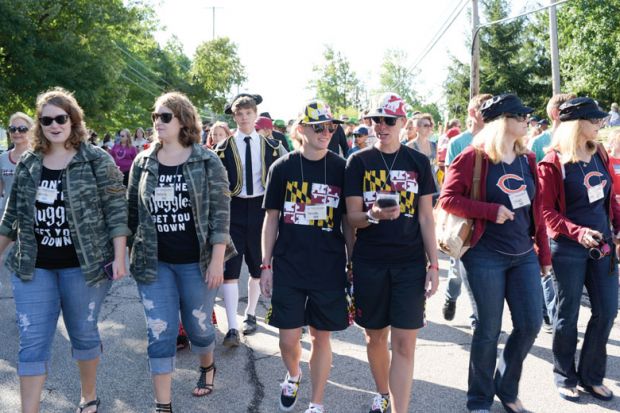US colleges appear to be rapidly increasing their class offerings to high school students in search of much-needed gains in enrolment and social equity, but some are growing wary of the accumulating costs while they await the expected pay-offs.
About 1.5 million high-school students are now believed to be taking at least one college-level class, in a system commonly known as dual enrolment or concurrent enrolment. The overall figure jumped an estimated 11 per cent this semester, according to new preliminary estimates by the National Student Clearinghouse.
“The dual enrolment programmes are quite large now” in the US, said John Fink, a senior research associate at the Community College Research Center, based at Teachers College at Columbia University. “They've been growing steadily for the past couple of decades.”
Yet the practice often still reflects its origins as a fringe benefit for students in wealthier school districts, according to Mr Fink and his team at Columbia. While decades old, dual enrolment is only gradually emerging as a potentially important tool for helping lower-income and minority students get exposure, encouragement and initial success in a post-secondary career, his team has concluded.
“What we do know is that in general, and in most circumstances, these courses really do benefit students – there’s been decades of research showing positive outcomes for high school completion, college enrolment and success,” Mr Fink said. “But we also know that in general, first-generation, low-income, students of colour don’t have equal access to these programmes.”
The US produces about 3.6 million high school graduates each year, and dual enrolment is one of the two most popular pathways through which they finish with some college credit. The other is Advanced Placement, or AP, a programme created by the College Board in which selected high school classes can count toward a college transcript if the student passes the corresponding AP test at the end of the course.
The AP option is about twice as large as dual enrolment, with close to 3 million high school students taking at least one AP class and nearly half that many taking an AP exam. Like AP, the dual enrolment model relies heavily on classes taught by authorised high school instructors, in high school buildings. The AP system has also been characterised as having longstanding racial imbalances. But dual enrolment may prove more popular over time, experts said, because obtaining college credit does not depend on passing a single final exam.
The usual partner for dual enrolment is a nearby community college, although some 30 per cent of the programmes now involve a four-year institution. One of the nation’s most active is Utah Valley University, a 43,000-student institution offering associate, bachelor’s and master’s degrees, which has a dual-enrolment cohort now numbering almost 14,000. Its programme arose in the 1980s, said UVU’s senior director of concurrent enrolment, Spencer Childs, primarily to help area high school seniors “fight senior-itis” – the traditional loss of focus as the finish line nears – “by giving them some college courses to start looking forward to”.
From there, Mr Childs said, the idea quickly moved to juniors and sophomores. Some 70 per cent of the participating high school students are taking only one to three classes, he said. “They’re just kind of getting their toes wet, which is great,” he said.
Equity, however, has taken over as a driving focus for UVU, Mr Childs said. Dual enrolment students in Utah pay just $5 (£4) per credit hour, meaning most classes are $15. “That makes it accessible to everybody,” he said.
Yet UVU’s exceptionally large growth is enabled by a model that may not work everywhere. The low student fee is made possible by a state budget appropriation. And UVU has given more than 500 high school teachers approval to teach its courses. “Typically we’re looking that they've got a master’s degree, hopefully in the area” that they are teaching, Mr Childs said.
UVU doesn’t have hard data on how well the programme is improving access to higher education among disadvantaged students, but Mr Childs is confident that it is happening. “One of the best benefits of the programming is, yes, you’re getting some college credit, but you’re getting some confidence to help you to recognise that hey, you can do college, you can be successful at that,” he said.
That seems a common situation across the US, Mr Fink said, with college leaders optimistic that dual enrolment will prove a strong tool for growing enrolment, especially among disadvantaged populations, but with strong proof of such outcomes still pending.
Uncertainty about costs is part of the long-term anxiety for institutions, Mr Fink said. “We hear this as a concern among college leaders – that it is a growing and large population, but we’re only getting a percentage of the revenue from the courses,” he said.
“What’s encouraging, what I’m really hopeful about,” he said, “is that college leaders and the folks running these programmes are really focused on this – they see it as a right thing to do.”
POSTSCRIPT:
Print headline: Will ‘dual enrolment’ surge promote social equity?
Register to continue
Why register?
- Registration is free and only takes a moment
- Once registered, you can read 3 articles a month
- Sign up for our newsletter
Subscribe
Or subscribe for unlimited access to:
- Unlimited access to news, views, insights & reviews
- Digital editions
- Digital access to THE’s university and college rankings analysis
Already registered or a current subscriber? Login








